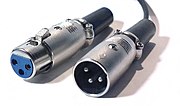Uncleyug asked about which preamp output to use over in the "Upper Midwest" thread, and I made a fairly detailed reply, which I will post here.
One thing I will add before I paste in my comments from the other thread, is to reiterate the comment that headphones with very low impedence will be thirsty for current (and hence, power) so a dedicated headphone amp will help them sound their best.
anyone have an understanding of ohms? my pre has dual-1/4" balanced outputs @ 600ohms, and an 1/8" unbalanced output @ 50ohms. what the difference?
I know enough to be dangerous. Ready for the long version??!

Ohms is a measurement of resistance to direct current (DC) flow, or in the case of alternating current (AC) signal like an audio signal, the function is called Impedance, and it's measured in Ohms. The two most important tidbits I remember from high school electronics class are
Ohm's Law and the power formula (voltage in Volts * current in Amperes = power in Watts)
Ohms's Law:

where I is the current in amperes, V is the potential difference between two points of interest in volts, and R is a circuit parameter, measured in ohms (which is equivalent to volts per ampere), and is called the resistance.
Essentially, what it means is that a "high impedance" circuit will have less current flow than a "low impedance" one at the same voltage level- in other words, a low impedance input is thirsty for more juice than a high impedance one.
Now with regard to outputs - the important thing about audio is the "
balanced" vs "unbalanced" - To balance a circuit, there has to be three conductors. One is the ground, or zero reference. The other two are called plus and minus. Plus is your audio signal, compared to ground. Minus is a phase-inverted version of plus, and it's basically used as a safety copy at the receiving input in order to cancel any noise induced along the cable. This is how microphone cables with 3 conductors can be used to carry signals extremely long distances (1/4 mile is not impractical!)

Now when you say you have an unbalanced output at 50 Ohms, I bet you are skipping something. Unbalanced outputs are usually in the 50
K Ohm range. This means that the output only sends a little bit of current for each voltage change (think of Voltage as water pressure, and Current as rate of water flow)
Normal home (consumer) audio connections are all unbalanced. Your 1/8" mini output is most likely going to be a normal unbalanced, two-conductor "Tip-Sleeve" audio output. Your 1/4" balanced output is going to be a three-conductor "Tip-Ring-Sleeve" output. If your recorder or A>D converter has unbalanced inputs, it will be easiest to use the 1/8" output on the preamp. If your recorder or A>D has
XLR connections you will probably want to use an adaptor to take advantage of the balanced circuit.
